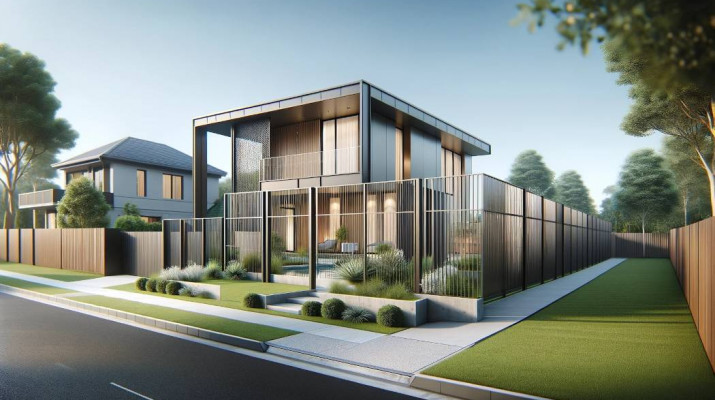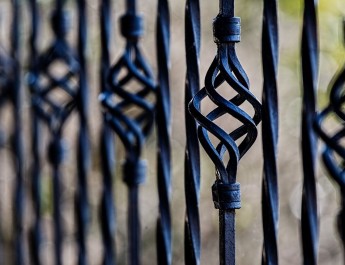Choosing the right fence for your property is a decision that affects not just aesthetics, but also functionality and security. In this guide, we will look at the key factors to consider when selecting a fence.
Understanding Your Needs
The first step in choosing a fence is understanding what functions it needs to serve. Is the main goal to provide privacy, security, or is it a decorative element of the landscape? Answering this question will help narrow down the choice of materials and styles.
Choosing the Material
Fences can be made from a variety of materials, each offering different benefits and having different maintenance requirements:
- Wood is a classic choice, providing warmth and a natural look. However, it requires regular maintenance such as painting or staining.
- Metal (steel, aluminum) is durable and offers a high level of security. Metal fences are also available in many styles.
- PVC or vinyl are low-maintenance options, available in many colors and styles. They are resistant to weather conditions and do not require painting.
- Stone or brick are the most expensive options, but they offer a unique and durable visual effect.
Matching Fence Style to Home Architecture
Choosing the right style of fence is crucial not only for aesthetics but also for the visual cohesion of the entire property. The right style can enhance the character of the house and garden, and affect the perception of the entire property.
The style of the fence should complement the architectural style of the property. Modern homes may look better with minimalist, metal fences, while traditional homes may benefit from ornately decorated wooden fences or elegant stone or brick walls.
Modern Style
For modern homes, characterized by simplicity of lines and minimalist form, fences with a simple, geometric structure are ideal. Metal panels, especially in subdued, neutral colors like gray, black, or white, will perfectly complement modern architecture. Consider also transparent fences made of tempered glass, which secure the property while maintaining an open, spacious character of the area.
Traditional Style
For homes in a traditional style, which often include more ornamentation and richer architectural details, suitable fences include wooden or wrought metal fences. Wooden fences can be customized to match the home’s style through the choice of colors, patterns, and finishes of the posts. Wrought fences, with their classic designs and decorations, add elegance and are often chosen to surround homes of a more lavish character.
Rustic Style
Homes with a rustic character, such as cabins or country houses, blend well with natural materials. Wooden fences made from unprocessed logs or planks, which naturally age over time, can perfectly match the surroundings. Alternatively, stone fences or those with a stone appearance can further enhance the raw, natural character of such a home.
Eclectic Style
For homes that mix different architectural styles, the choice of fence can be more flexible. Here, it is important for the fence to harmonize with the most dominant architectural elements or to be an interesting, artistic accent itself. Combining different materials, such as metal with wood, or adding glass elements in a metal frame, is possible.
Choosing the style of a fence should be done thoughtfully, considering both the style of the home and individual needs and preferences. A well-chosen fence style not only enhances the aesthetic value of the property but also increases its market value.
Legal Aspects of Installing a Fence
The decision to erect a fence on your own property is not only a matter of aesthetics and functionality but also requires familiarity with local legal regulations. Non-compliance with these rules can lead to the need to dismantle the fence or even to legal disputes. Below are the most important legal aspects to consider before starting work.
1. Building Permits
In some locations, installing a fence may require obtaining a building permit. This procedure is often necessary when the planned fence exceeds a certain height or is built in a specific area, such as near a public road. To avoid problems, it is best to contact the local municipal or city office to find out if a permit is required in your case.
2. Local Regulations
Each municipality may have its own regulations regarding fences, including restrictions on height, materials, colors, or even the style of the fence. There are also often special regulations for historic areas, where new constructions must harmonize with existing buildings. It is necessary to familiarize yourself with the local spatial development plan or the community housing association’s regulations, if one exists.
3. Property Boundaries
Before installing a fence, it is essential to precisely determine the property boundaries. In cases of uncertainty about where exactly the boundary lines run, it is advisable to hire a surveyor. Installing a fence beyond the boundaries of your own plot can lead to disputes with neighbors or even the necessity of relocating it.
4. Neighbor’s Rights
Remember that a fence often also affects the interests of neighbors. In some cases, neighbors may have legally guaranteed rights to light, views, or access to a road. Installing a fence that restricts these rights can be considered a violation of local regulations.
5. Safety and Access for Services
A fence should not restrict access to the property by emergency services. In many places, there are regulations specifying how fences must be constructed to not obstruct access in an emergency.
Knowledge and adherence to local legal regulations are crucial when planning the installation of a fence. Keep in mind that regulations can vary depending on the location, so it is always worthwhile to consult with the municipal office or a legal advisor. This ensures that the fence installation process runs smoothly, and the final result meets expectations and legal requirements.
Cost and Installation of a Fence
Planning the costs and installation of a fence is an important stage that affects the final appearance and functionality of the property. To avoid financial and technical surprises, it is worth getting acquainted with all aspects of this process.
Cost Estimation
The costs of installing a fence depend on many factors, including the type of material, length of the fence, terrain difficulties, and labor costs. Here are some typical cost components to consider:
- Materials: Prices vary significantly depending on the chosen material. For example, wood is usually cheaper than metal or stone but may require more frequent maintenance.
- Terrain preparation: Removal of old fences, leveling of the terrain, and even the removal of trees or shrubs may be necessary before installing a new fence.
- Length and height of the fence: Greater length and height of the fence increase the use of materials and labor time, which translates into higher costs.
- Gates and gates: Installing gates and gates is an additional cost that is often essential for the functionality of the fence.
Choosing a Contractor
Choosing the right contractor is as important as choosing the material. A good contractor not only offers a fair price but also guarantees the quality of the work, which is crucial for the durability of the fence. It is advisable to obtain several offers and check reviews and references before making a final decision.
Installation Process
The installation of a fence can vary depending on its type and the specific requirements of the material:
- Marking the area: Before starting work, it is necessary to accurately mark where the fence will be placed, which often requires professional measurement.
- Digging foundations: For most fences, solid foundations are needed, which often means digging holes for posts.
- Installing posts: Posts must be properly secured, which usually involves using concrete to ensure stability.
- Installing panels: The final step is installing the fence panels or other elements between the posts.
Installation Time
The time required to install a fence depends on its length and the difficulty of installation. Simple panel fences can be installed within a few days, while more complex constructions, such as stone fences, may require several weeks of work.
Planning a budget for a fence and choosing the right contractor are key steps that determine the success of the entire project. Careful consideration of each aspect of the installation process helps avoid future problems and ensures satisfaction with the completed investment. Before starting, also make sure that all work complies with local legal regulations and safety rules.
The cost of a fence depends on the chosen materials, length of the fence, and the terrain on which it is to be installed. Professional installation can be expensive, but it ensures proper execution of the work, which is crucial for the durability and functionality of the fence.
Choosing the Ideal Fence for Your Property Is a Process
Choosing the ideal fence for your property is a process that requires thought and planning. When making a decision, it is important to focus not only on aesthetics but primarily on functionality and maintenance requirements.

